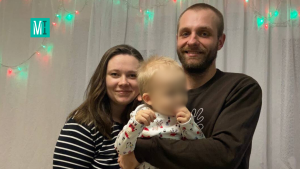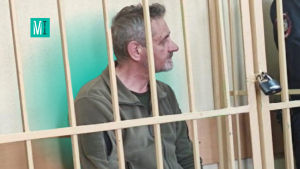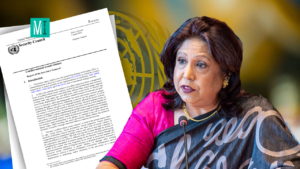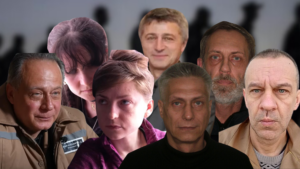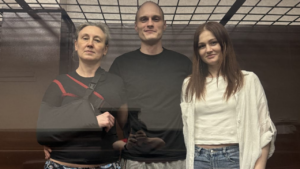General Lapin’s headquarters: the occupation of Chernihiv Region through the eyes of a local resident
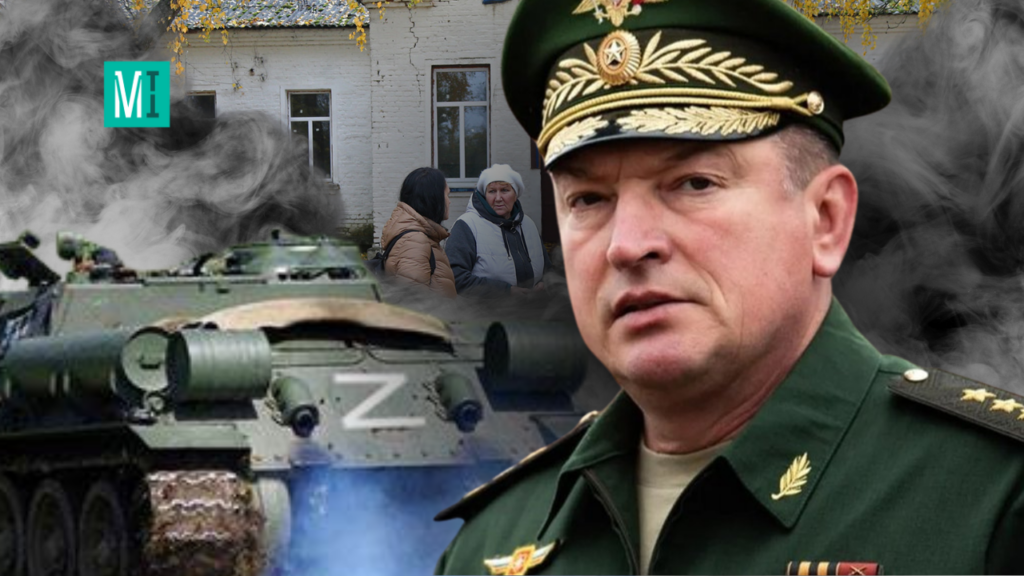
Olena Kovalyova manages the Community Center in Terekhivka. While under occupation, this village served as a temporary home for Russian Colonel General Alexander Lapin, the then commander of the Central Military District of the Russian Federation. Under his command, the enemy forces attempted to capture Kyiv, Chernihiv, and Sumy Regions. However, this was not destined to happen, as the Russians were driven out by the Ukrainian Armed Forces. MIHR visited Terekhivka to find out what happened there and to document the war crimes committed by the Russian military.
“Olena, some ‘friends’ in Kevlar helmets are here to see you,” Petro shouted to his wife, entering the house from the street.
Olena Kovalyova immediately understood whom her husband was referring to — their native Terekhivka had been living under occupation for over two weeks. It was the Russian military who walked around wearing Kevlar helmets there.

Olena Kovalyova, manager of the Community Center in Terekhivka. Photo by Victor Kovalchuk
It was March 13, 2022, and two armed men were waiting at the gate. The frightened woman did not go out to them, so they talked through the fence. Olena was surprised not so much by the visit of the uninvited guests as by the fact that they knew her name and place of employment — the woman manages the local Community Center.
“And how do you know my name?” she inquired.
“We were told where you live, what your name is, and where you work,” confessed one of the men.
The invaders did not reveal their source, but Olena understood it to be one of her fellow villagers. The second Russian did not join the conversation, but a few minutes later it became clear what they wanted from her. It turned out that they saw a notice board with photos of ATO fighters on the wall in the Terekhivka village council. So they came to the woman to inquire about ATO veterans and their families.
“They are from Chernihiv District. Nobody from our village served in the military! We posted whatever photos they sent to us,” she lied without batting an eyelid.
In reality, Olena knew exactly that the photos were of boys from Terekhivka, who served in 2014. Later, her husband Petro would say that she “lied so convincingly that she believed her own lie.”

Olena Kovalyova tells MIHR fact finders about the occupation of Terekhivka. Photo by Victor Kovalchuk
The Russian soldier asked again because he didn’t quite understand her Chernihiv dialect (Olena calls it “a Terekhivka dialect”), but she just bluntly cut him off:
“I talk the way I talk.”
The Russian soldier tried to ask for details again, but in vain: citing illness, the woman turned towards the house, trying to end the unpleasant conversation as soon as possible.
“I would go on a reconnaissance mission with you,” the Russian said in the end.
“And I wouldn’t go with you,” — she responded.
“Why not?” the man asked in surprise.
“Because you are fascists and invaders.”
General Lapin and his son
The soldier who questioned Olena Kovalyova later died in the Ripky district of Chernihiv Region. According to the woman, he went to the village of Vyshneve, where the Russians had their headquarters, and on the way there his convoy was obliterated by the Ukrainian Defense Forces.
She also remembers the other man who stood silently during the conversation. Olena recognized him to be Denis Lapin — the 38-year-old son of Russian Colonel General Alexander Lapin, who at the time of the full-scale invasion commanded the troops of the Central Military District of the Russian Federation.

Alexander Lapin, at the start of the full-scale Russian invasion of Ukraine — commander of the Central Military District troops. Photo courtesy of New Voice
As of February 2022, Lapin Junior was a lieutenant colonel in the Russian Armed Forces, commanding the 1st Guards Tank Regiment, part of the 2nd Taman Motorized Infantry Division. Ukraine’s Central Intelligence Directorate names him among perpetrators of war crimes in Ukraine. In March 2022, Ukrainian forces posted a video on YouTube in which a captured Russian Armed Forces captain, Rasim Tagiyev, testifies that on February 24, 2022, at the head of a convoy of 30 tanks, he crossed the state border with Ukraine, and his commander was Denis Lapin. Another captured Russian soldier — corporal, senior scout Alexey Savelyev — also confessed that the order to cross the border was given by Denis Lapin himself.
Later in March 2022, Kovalyova met Lapin Junior again when she came with the godmother of her child to the Terekhivka Community Center to retrieve her diplomas. The Russian lieutenant colonel came out to them and threatened that next time he would detain them if the women walked around the village without permission.

Denis Lapin, commander of the 1st Tank Regiment of the 2nd Guards Taman Motorized Infantry Division (military unit 58198), was a lieutenant colonel at the time of the Russian invasion of Ukraine. Photo courtesy of the “War and Sanctions” project
After the liberation of her village, the woman reported these encounters to Ukrainian prosecutors investigating the circumstances of the Russian military’s presence there. Kovalyova also appear in the Chernihiv District Court as a witness and testified in the case of Lapin.
Headquarters in the Community Center
The Community Center, managed by Olena, became a base for Russian military from the first days of the occupation of Terekhivka. The enemy soldiers brought beds from village houses, setting up improvised barracks. They did not care much about hygiene — they set up a toilet right there in the building. The only room where relative order was maintained was the one occupied by General Alexander Lapin.

The Terekhivka Community Center, where the Russians were stationed. Photo by Victor Kovalchuk
Before the full-scale invasion, he fought in the Second Chechen War, but the general’s name was primarily associated with Russia’s military operations in the Middle East. In 2017, Lapin was appointed chief of staff of the Russian forces in Syria, and in 2018–2019, he already commanded these forces.
Russian media outlet Meduza, citing the propagnda Telegram channel Rybar, retells the memories of one of those who were in Syria with Lapin:
“I had to personally deal with Lapin during the first capture of Palmyra. Before our eyes, the Russian general was dragging the Syrian cartoonish warlords to the front line, smashing radios against their heads when they couldn’t report on the whereabouts of their troops that had fled the battlefield.”
After such an “initiation” in the Middle Eastern latitudes, the Russian leadership sent Lapin to Ukraine. According to information from Ukraine’s Prosecutor General Andriy Kostin, the general was tasked with capturing three Ukrainian regions — Chernihiv, Sumy, and Kyiv. In May 2023, military historian Mykhailo Zhirokhov reported that Lapin had set up his headquarters precisely in Terekhivka under Chernihiv: “And all the command authorities were stationed there [in Terekhivka]. His son [Denis Lapin] served alongside him in the rank of lieutenant colonel. He commanded one of the tank regiments of the division, which was subordinated specifically to Alexander Lapin.”

View of the Community Center after the de-occupation of Terekhivka. Here the Russians set up their headquarters. Photo by Victor Kovalchuk
Local resident Olena Kovalyova confirms that General Lapin stayed in Terekhivka. However, she believes that although the Russians lived in the Community Center, their headquarters was not there, but in the village of Vyshneve in the Ripky district. General Lapin, she says, came to Terekhivka after the shelling of the neighboring village of Malynivka, located 4 km away:
“How did I understand that? Because our girls, milkmaids, when they went to the farm to milk the cows, they drove this way. And when he arrived, they said there was an armored vehicle parked there. No one was allowed to come here, there was security. No one walked down this street — it was forbidden.”

Trash left by the Russian military in the Terekhivka Community Center. Photo by Victor Kovalchuk
It was right next to the Terekhivka Community Center on March 29, 2022 that Lapin awarded medals to tankmen, including his son Denis. According to some sources, he received the rank of colonel after the full-scale invasion. The Russian propaganda TV channel Zvezda filmed this award ceremony. In the footage circulated all over the Internet, the general awarded the Order of Courage, the Medal “For Valor”, the Order “For Merit to the Fatherland”, and the Zhukov Medal on Russian military personnel. The latter award went specifically to Denis Lapin.
The irony of the situation is that by that time, under the pressure of the Ukrainian Armed Forces, the Russian army was already retreating from the Chernihiv and Kyiv directions. Lapin failed to capture either Chernihiv, Sumy, or Kyiv. By early April 2022, all three regions were completely liberated from the invaders, and Lapin himself became the object of mockery and vehement criticism by Evgeny Prigozhin, leader of the infamous Wagner Group, and the head of the Chechen Republic, Ramzan Kadyrov. The latter called the general a failure also for failing to defend the Russian-captured town of Lyman in Donetsk region. Many Russian officials and bloggers blame Lapin for the Russian army’s defeat near Izyum, Balakliya, and almost the entire retreat from Kharkiv Region. In late October 2022, the colonel general was dismissed from the position of commander of the Central Military District of the Russian Federation.

Alexander Lapin awarding his son Denis Lapin the Zhukov Medal. Photo: screenshot from the story of the propaganda TV channel Zvezda
In 2023, the Chernihiv District Court began an in-absentia examination of the case against Alexander Lapin. Olena Kovalyova came to these hearings as a witness — she talked about the general’s stay in Terekhivka. He is charged with committing offenses under part 3 of Article 110 of the Criminal Code of Ukraine (encroachment on the territorial integrity and inviolability of Ukraine, resulting in the death of people or other grave consequences) and part 2 of Article 437 of the Criminal Code of Ukraine (conducting an aggressive war or aggressive military actions).
Murder of Yuriy Mustipan
Fortunately, after the liberation of Terekhivka no mass burial sites of killed Ukrainians were found here. However, this village also has tragic stories about people tortured and executed by the Russians.
One of the victims of the invaders was Yuriy Mustipan, who, according to Olena Kovalyova, lived in the neighboring village to Terekhivka.
“We weren’t very close. We would just say hello on the street, that’s all,” she remembers him, noting that Mustipan walked on foot to Chernihiv after the full-scale war began. “Why he went there is unknown for sure. They say that there were two small children in the neighboring village, so he supposedly went to get diapers for them. But why not the father, but he himself, I don’t know. They also say that he was detained on his way back — they supposedly found some photos in his phone. But I don’t know whether or not there were any photo.”

Yuriy Mustipan, killed by the Russian military. Photo courtesy of the Memorial Memory Platform project
The Memorial Memory Platform project’s website, which catalogs information about Ukrainian civilians and soldiers killed by the Russians, also contains information that 47-year-old Yuriy Mustipan set off on foot from Terekhivka to Chernihiv on March 19, 2022. Referring to the deceased man’s wife, the project authors write that the man intended to pass enemy coordinates to the Ukrainian military. Besides, Mustipan supposedly wanted to see his relatives living in Chernihiv and buy some stuff for the children of fellow villagers. “Yuriy was a topographer in the army, he navigated the terrain well,” the site quotes Tetiana, the man’s wife, as saying. On the way back, Mustipan was detained by the Russian military.
“The wife [Tetiana] started coming over and saying that he was missing,” Olena Kovalyova continues. “And then one of the locals said that they saw how he was brought here [to Terekhivka], how they took him out of the community center, and placed him onto an APC. Later, a local farmer reported that someone was lying behind the farm, but he couldn’t recognize who it was because the whole face was beaten beyond recognition. Then the wife went to look and recognized Yuriy.”
Kovalyova specifies that the Russians allowed Tetiana to take the corpse and bury him:
“At first, he was buried here, but later he was exhumed and it was established that he received a control shot to the head.”
According to Memorial, the Russians shot Mustipan on March 24, and on March 30, the wife identified his body. The man worked as a minibus driver. Besides his wife, Mustipan left behind parents and two sons. On April 24, 2022, he was posthumously awarded the medal “For Assistance to the Armed Forces of Ukraine.”
Murder of Ihor Naumenko
Olena recalls another horrific murder — the Russians shot and killed a resident of the neighboring village Tovstolis, Ihor Naumenko, in front of his wife and children.
The invaders occupied Tovstolis late in the evening of February 25, 2022. Those who lived on Druzhby Street (the village has only two streets — Druzhby and Lisna) were ordered to leave their homes so that the Russian military could move in. People decided to go to the village of Petrushyn, 10 km away. Among them was Ihor Naumenko with his family.

Ihor Naumenko, killed by the Russian military. Photo courtesy of Ukrainian Pravda
Journalist Natalia Naydiuk of Ukrainian Pravda. Life writes in an article about the man’s killing that the invaders promised people a safe passage and that no one would shoot them. The convoy consisted of about ten cars and a minibus. Naumenko was driving his wife Svitlana and two sons — 13-year-old Ivan and 11-year-old Danylo, who were sitting in the back.
“Naumenko started to overtake a car at a bend in the road, and the Russians opened fire on him, shooting him in front of his wife and children,” says Olena. “We heard the shots. My child’s godmother told me that Russian soldiers ran up saying that there was a wounded man, their hands in blood. They washed their hands near the well and repeated: ‘Everything is fine, we sent him to the hospital’.”
The deceased man’s wife, Svitlana, recalls in a comment to UP. Life: “We almost reached the Russian checkpoint near Terekhivka, and then suddenly someone opened fire. Ihor turns to me and swears: ‘What the hell’. And that’s it, the car stalled, and Ihor went silent and slumped over the steering wheel.”
A medic ran up, pulled the motionless man out of the car, and laid him on the ground. The Russians assured the woman that the wound was not fatal, that they had given him an injection and would now take him to the hospital. Svitlana and the children were put in another car in the convoy. Two days later, her aunt from the town of Sednev, 30 km from Tovstolis, called her to tell that Ihor’s body was found. The Russians had left him under the local clinic. Naumenko had gunshot wounds to the head and chest.
Initially, the man was buried in Sednev, and after the de-occupation in early April, the body was exhumed and reburied in the cemetery in Tovstolis. Forensic experts established that the man died on February 27, i.e., when the convoy on the way to Petrushyn was fired at.
The liberation of Terekhivka
On March 30 or 31 (Kovalyova doesn’t remember the exact date), the Russian military announced that the people of Terekhivka had to gather in the village center, where they would be given “humanitarian aid.” Olena initially didn’t want to go, but a neighbor convinced her to see what was happening. When they arrived, the center of Terekhivka was crowded.
“All our fellow villagers were there. Standing, happy to be alive,” the woman recalls.
The Russians, however, were tense. According to Kovalyova, they were running around with backpacks, and the streets were filled with a large number of tanks, ready to move. Such activity of the invaders was frightening, so she and her neighbor hurried home. Before that, they called on their fellow villagers to disperse. Olena warned that a Russian photographer might come to take pictures of the crowd and present it as if people were gratefully seeing off the Russian army.

At the end of March 2022, Russia began actively withdrawing its troops from the northern regions of Ukraine, and by April 3, the invaders had completely left Chernihiv region. Photo by Victor Kovalchuk
When the woman was already at home, sudden silence fell over the village. Olena and her husband went to the neighbors to fetch water. On the way, they saw armed Russian soldiers hiding under an embankment.
“They probably thought our forces would advance, so they set up ambushes here. And then my husband said the pontoon was making slapping noises. And we heard Russian military vehicles crossing the river,” Kovalyova recalls.
The enemy hastily left the village, which had been occupied for over a month.
Yevheniya Koroliova, journalist, exclusively for MIHR


